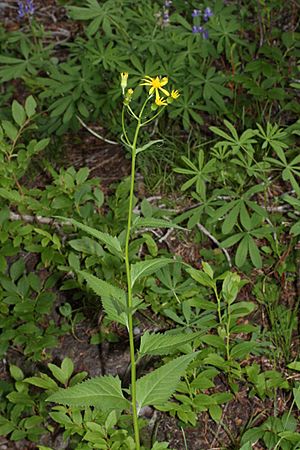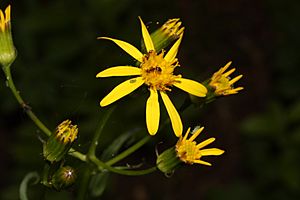Senecio triangularis facts for kids
Quick facts for kids Senecio triangularis |
|
|---|---|
 |
|
| Senecio triangularis in Mount Rainier National Park | |
| Scientific classification | |
| Synonyms | |
|
Senecio gibbonsii Greene |
Senecio triangularis, known as arrowleaf ragwort, arrowleaf groundsel and arrowleaf butterweed, is a species of the genus Senecio and family Asteraceae.
Contents
Description

It is similar in form to Senecio serra, both being four feet tall, have narrow and serrated leaves, and are topped with many small, yellow sunflowers. but S. triangularis is more common than S. serra. S. triangularis has single erect stems, reaching up to 10–120 cm (4–47 in) tall. The stems have evenly distributed leaves. The leaves are triangular, with tapered ends, hence the name. The flowers have a prominent central dome, with ray florets around 8 cm wide.
As some plants are diploid, meaning having two sets of chromosomes, this can be used to identify hybrids and classification of groupings. It has been counted as 2n = 40, 80.
It is native to temperate regions of America and is reportedly poisonous to animals.
Taxonomy
It has the common names of arrowleaf ragwort, arrowleaf groundsel, and arrowleaf butterweed.
In the early 1830s, Scottish botanist Thomas Drummond collected this plant, probably on his second trip to the United States. The plant was named by William Hooker, Drummond's mentor, and first published and described by Hooker in 'Flora Boreali-Americana' (Fl. Bor.-Amer.) Vol.1 on page 332 in 1834.
Distribution
- Native
- Nearctic:
- Subarctic America: Northwest Territory, Yukon Territory, Alaska
- Western Canada: Alberta, British Columbia
- Northwestern United States: Colorado, Idaho, Montana, Oregon, Washington, Wyoming
- Southwestern United States: Arizona, California, Nevada, Utah, New Mexico
Source: GRIN,
Habitat
It grows in open woodlands, (mainly coniferous forests) and on rocky stream sides. They can grow at altitudes of between 100 to 3,500 m (330 to 11,480 ft).

